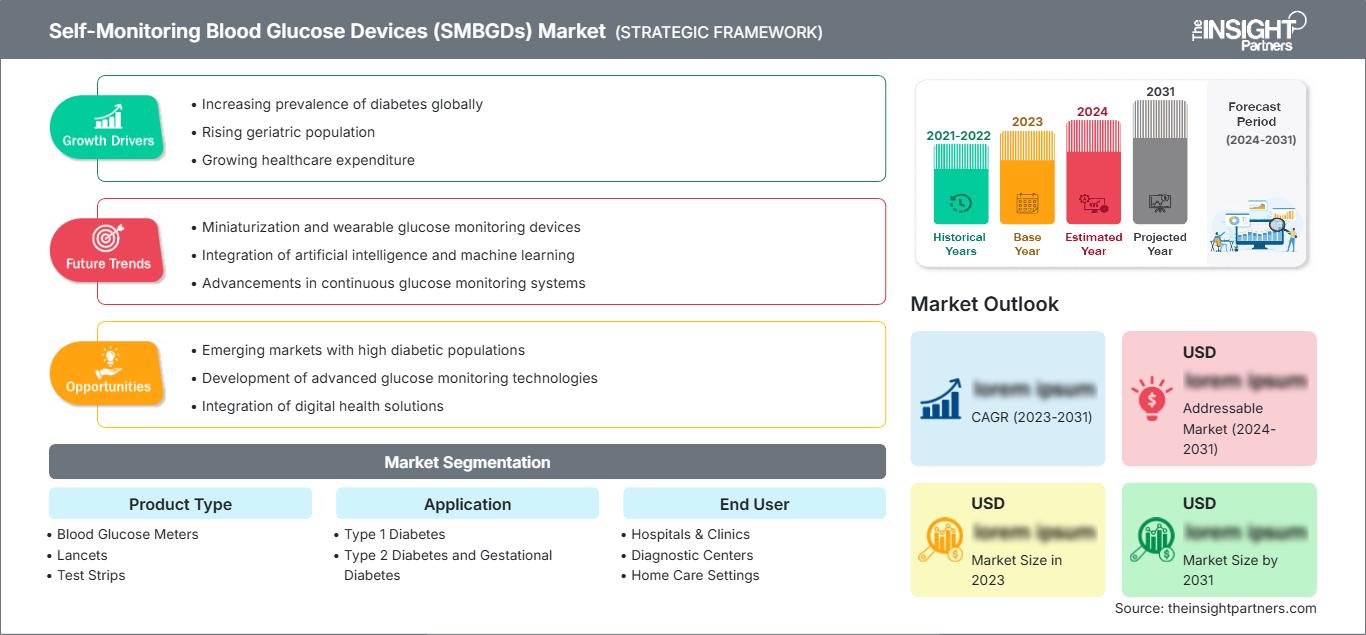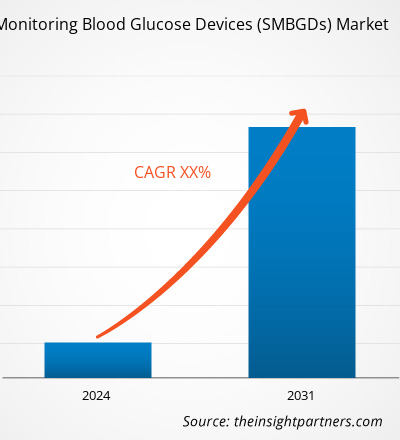自我血糖监测设备市场规模预计将从 2023 年的 95 亿美元增长到 2031 年的 224 亿美元;预计该市场在 2023 年至 2031 年期间的复合年增长率将达到 11.3%。糖尿病患者对远程血糖监测的日益增长的偏好推动了自我血糖监测设备市场的增长。然而,产品召回阻碍了市场的增长。
增长动力:
糖尿病患者对远程血糖监测的日益增长的偏好
美国食品药品监督管理局 (FDA) 支持使用提供准确读数的血糖仪进行远程血糖监测。一些家用血糖仪内置无线数据传输功能,可方便患者进行远程血糖监测,带来便捷体验。因此,FDA 鼓励监管支持和政策支持,允许糖尿病患者使用家用血糖仪进行自我检测。
雅培的“Cobas Pulse”系统就是智能自测血糖仪的一个例子。它是一款高端性能的血糖仪,结合了“Cobas Infinity”技术,提供安全数字化的管理软件解决方案。因此,糖尿病患者对远程血糖监测设备的日益青睐将对自测血糖设备市场规模产生积极影响,促进市场扩张。
自定义此报告以满足您的要求
您将免费获得任何报告的定制,包括本报告的部分内容,或国家级分析、Excel 数据包,以及为初创企业和大学提供超值优惠和折扣
自我监测血糖设备(SMBGD)市场: 战略洞察

- 获取本报告的主要市场趋势。这个免费样本将包括数据分析,从市场趋势到估计和预测。
您将免费获得任何报告的定制,包括本报告的部分内容,或国家级分析、Excel 数据包,以及为初创企业和大学提供超值优惠和折扣
自我监测血糖设备(SMBGD)市场: 战略洞察

- 获取本报告的主要市场趋势。这个免费样本将包括数据分析,从市场趋势到估计和预测。
报告细分和范围:
自我监测血糖设备市场分析考虑了以下细分市场:产品、应用、检测站点和最终用户。
细分分析:
按产品细分,市场分为试纸、血糖仪、采血针等。试纸细分市场在 2023 年占据了自我监测血糖设备最大的市场份额,预计在 2021-2031 年期间将实现 11.8% 的最高复合年增长率。2021 年 10 月发布的克林顿健康倡议 (CHAI) 显示,试纸是自我监测血糖设备市场的主要收入来源。这是因为大量糖尿病患者每天需要使用多条试纸,导致试纸消耗量巨大。此外,许多供应商免费向糖尿病患者提供血糖仪,这也推动了试纸的销售。为了进一步加速试纸的消耗,供应商限制了专有试纸与特定血糖仪型号的兼容性,使得试纸无法与其他品牌的血糖仪甚至同一品牌的其他型号兼容。
自我监测血糖仪市场趋势 基于远程医疗的自我监测血糖仪
在传统医疗实践中,问诊时会建议患者改变生活方式和更换药物。在某些情况下,这些面对面的问诊可能不可行,而且成本高昂。远程医疗技术的最新进展不仅成为提供糖尿病管理服务的有前景的平台,而且还有助于减少不必要的医疗资源配置。基于远程医疗的自我血糖监测设备已具备传输功能,可连接到智能手机应用程序或网站。患者可以方便地自行测量血糖水平,并实时与医疗团队分享结果。例如,科罗拉多州芭芭拉·戴维斯中心的临床医生使用 Dexcom 公司的“G6 软件工具”,为糖尿病患者提供虚拟护理,帮助他们自我管理血糖水平。此外,经临床验证,Dexcom 的 G6 可以降低糖化血红蛋白 (A1C),降低高血糖和低血糖水平,并提供一系列安全警报。该产品适用于英语和西班牙语患者。因此,此类基于远程医疗的血糖监测设备的普及可以为自我血糖监测设备市场的增长提供丰厚的机遇。
区域分析:
自我血糖监测设备市场报告的范围涵盖北美、欧洲、亚太地区、南美和加勒比地区。中美洲、中东和非洲。2022年,北美占据了自我血糖监测设备市场的最大份额。顶级公司不断推出新产品,以及主要市场参与者的参与,都有利于北美市场的发展。美国是北美市场最大的贡献者,因为该地区拥有庞大的糖尿病患者群体,并且拥有开发和批准自我血糖监测设备的监管机构。
自我监测血糖设备 (SMBGD) 市场
The Insight Partners 的分析师已详尽阐述了预测期内影响自我血糖监测设备 (SMBGD) 市场的区域趋势和因素。本节还讨论了北美、欧洲、亚太地区、中东和非洲以及南美和中美洲的自我血糖监测设备 (SMBGD) 市场细分和地域分布。
自我监测血糖设备(SMBGD)市场报告范围
| 报告属性 | 细节 |
|---|---|
| 市场规模 2023 | US$ XX Million |
| 市场规模 2031 | US$ XX Million |
| 全球复合年增长率 (2023 - 2031) | XX% |
| 历史数据 | 2021-2022 |
| 预测期 | 2024-2031 |
| 涵盖的领域 |
By 产品类型
|
| 覆盖地区和国家 | 北美
|
| 市场领导者和主要公司简介 |
|
自我监测血糖设备 (SMBGD) 市场参与者密度:了解其对业务动态的影响
自我血糖监测设备 (SMBGD) 市场正在快速增长,这得益于终端用户需求的不断增长,而这些需求的驱动因素包括消费者偏好的演变、技术进步以及对产品优势的认知度的提升。随着需求的增长,企业正在扩展产品线,不断创新以满足消费者需求,并抓住新兴趋势,从而进一步推动市场增长。

- 获取 自我监测血糖设备(SMBGD)市场 主要参与者概述
行业发展和未来机遇:
自我监测血糖设备市场预测可以帮助该市场的利益相关者规划其增长战略。以下列出了一些市场领先企业的战略发展:
2023 年 3 月,安斯泰来制药 (Astellas Pharma) 宣布推出一款名为“TempoSmart”的胰岛素笔和一款名为“Tempo Pen”的预充式胰岛素笔,它们共同为糖尿病患者提供个性化指导。该应用程序是与 Welldoc 公司合作开发的,是该公司“BlueStar”的自有品牌版本,BlueStar 是一款定制的糖尿病管理应用程序,可从 Tempo Smart Button 接收胰岛素剂量相关数据。
竞争格局和主要公司:
B. Braun SE、F. Hoffmann-La-Roche、LifeScan Inc.、美敦力、雅培、Ypsomed Holding AG、Sensionics、Nipro Corp、GE Healthcare 和 Terumo Corp 等知名公司均是自我监测血糖设备市场报告中重点介绍的公司。这些公司专注于开发新技术、升级现有产品并拓展业务范围,以满足全球日益增长的消费者需求。
- 历史分析(2 年)、基准年、预测(7 年)及复合年增长率
- PEST和SWOT分析
- 市场规模、价值/数量 - 全球、区域、国家
- 行业和竞争格局
- Excel 数据集
近期报告
客户评价
购买理由
- 明智的决策
- 了解市场动态
- 竞争分析
- 客户洞察
- 市场预测
- 风险规避
- 战略规划
- 投资论证
- 识别新兴市场
- 优化营销策略
- 提升运营效率
- 顺应监管趋势




















 获取免费样品 - 自我监测血糖设备(SMBGD)市场
获取免费样品 - 自我监测血糖设备(SMBGD)市场